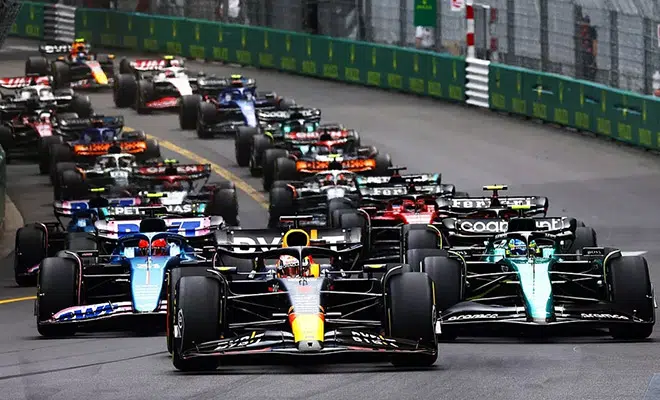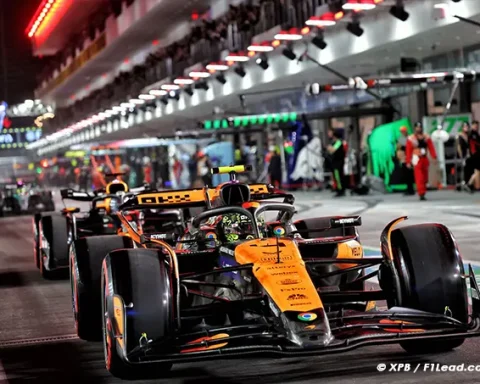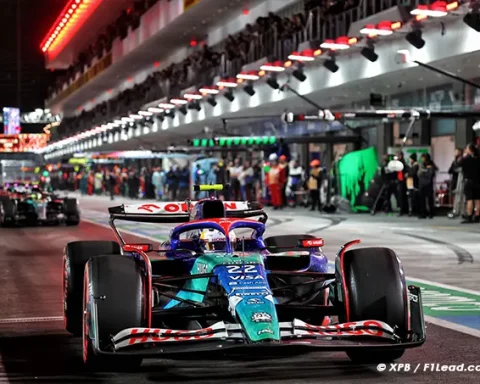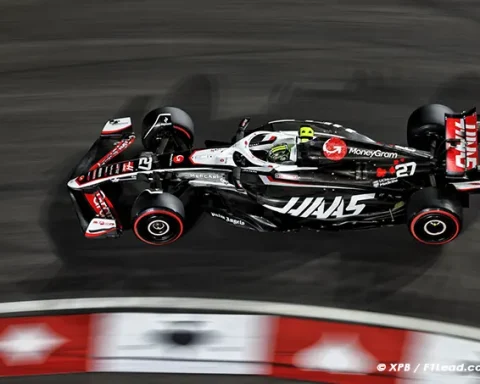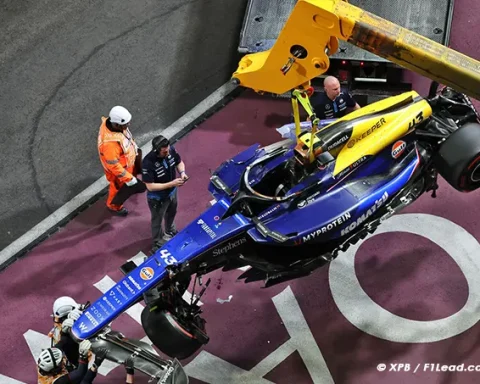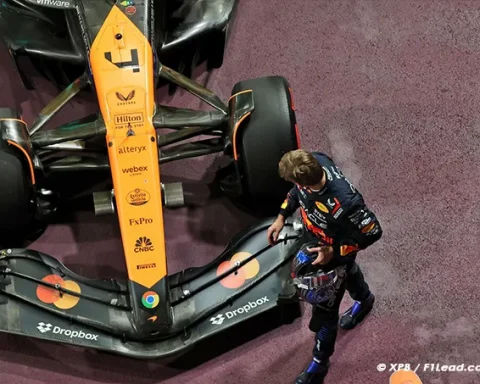Exploring Liberty Media’s radical overhaul of Formula 1, we delve into how they turned a traditional sport into a modern spectacle, revolutionizing its appeal and business model.
It should be clear to everyone that Liberty Media, the owner of Formula 1, has successfully shifted the course of the massive, hard-to-maneuver steamship that Formula 1 once was, transforming it into a huge, modern super-yacht. We’re discussing what they’ve done, the results, and providing an analysis with opinions, including pros and cons, here at F1Lead.
Liberty Media’s Extensive Revamp of Formula 1: A Modern Spectacle Emerges. The transformation of Formula 1 by Liberty Media has been nothing short of radical, turning a traditional motorsport into a contemporary phenomenon. This overhaul has brought about significant changes, injecting new life and a modern twist into the sport. The shift in Formula 1’s dynamics, under Liberty Media’s guidance, showcases a remarkable evolution from its classic roots to a thrilling, globally appealing event. Each step in this transformation has contributed to a rejuvenated and more engaging Formula 1 experience, aligning it with the demands of a changing audience.
Liberty Media’s Game-Changing Strategy in Formula 1
The history is well-known: Liberty Media acquired Bernie Ecclestone’s shares in 2016, as well as those of Bambino Trust, while already owning a significant stake in Formula 1, thus becoming the new owner. Liberty Media, a media company as its name suggests, has major interests in the audio world. The company’s big boss is Greg Maffei, who serves as both Chairman and CEO, with billionaire John Carl Malone owning the enterprise.
During the transition period, Chase Carey acted as CEO while Ecclestone managed the handover. Formula 1 then continued under Carey’s leadership and a year later, Stefano Domenicali took over as CEO. Ecclestone, an old-school figure and a natural-born racer, had little interest in social media and similar platforms. This is where Liberty Media made significant changes, one of the first being the collaboration with Netflix and the creation of the popular series “Drive to Survive,” which has greatly boosted Formula 1’s popularity, especially in the United States.
Liberty Media also focused on social media channels right after the acquisition, dragging Formula 1 into the modern world. What Ecclestone did well was selling or leasing the television rights, providing Liberty Media with a guaranteed source of income from the get-go. As a true American corporation, this formed the foundation for further development, giving Formula 1 a stronger commercial flavor, quite different from the British company Ecclestone had established.
Formula 1 Transformation – The Impact of Budget Caps.
In collaboration with the FIA, budget caps were introduced in 2019, officially to give each team a better chance at victories and championships by limiting the amount of money they could spend on racing, building, and transporting their cars. However, the impact has been more profound. Half of the teams were not profitable and were incurring losses. This led to frequent changes in team ownership, often for a nominal fee, sometimes literally for one (British) pound or even less.
Moreover, large teams backed by major manufacturers like Ferrari, Mercedes, and Red Bull, were spending annually on car development amounts that exceeded the budget of a small developing country. This unsustainable cost race saw expenses skyrocket each year. The smaller teams simply couldn’t compete, widening the gap between teams annually.
Another advantage of these budget caps, something the teams hadn’t considered, was the significant increase in their own value, as seen in Table 1 (source: Forbes). In theory, they could all be profitable now, as, in addition to the minimum annual prize money, they needed only around 50 million in sponsorship funds to meet their budget. In the table, dollar values are converted to euros at a rate of €0.91 per dollar. The big companies, which always had many deep-pocketed sponsors, became even more profitable and technically no longer needed sponsorship from their parent companies.
| Team | End Value | Gross Income | Net Income (EBITDA) |
|---|---|---|---|
| Ferrari | € 3,549,000,000 | € 619,000,000 | € 105,000,000 |
| Mercedes | € 3,458,000,000 | € 637,000,000 | € 175,000,000 |
| Red Bull Racing | € 2,366,000,000 | € 464,000,000 | € 77,000,000 |
| McLaren | € 2,002,000,000 | € 446,000,000 | € 53,000,000 |
| Alpine | € 1,274,000,000 | € 296,000,000 | € 46,000,000 |
| Aston Martin | € 1,251,000,000 | € 264,000,000 | € 29,000,000 |
| AlphaTauri | € 1,024,000,000 | € 237,000,000 | € 18,000,000 |
| Alfa Romeo | € 819,000,000 | € 191,000,000 | € 23,000,000 |
| Haas | € 710,000,000 | € 164,000,000 | € 2,000,000 |
| Williams | € 660,000,000 | € 146,000,000 | € 5,000,000 |
| Average | € 1,711,000,000 | € 346,000,000 | € 53,000,000 |
Races Becoming More Exciting.
In addition to this strategy, efforts were also made to make races more exciting. This led to the new 2022 regulations in collaboration with the FIA, reintroducing ground-effect cars after many years. These changes, along with the tightening of several other rules, resulted in cars being able to follow each other more closely and overtake more easily than before. The ground effect generates most of the downforce from the airflow beneath the car. It also significantly reduces the ‘dirty air’ around and behind a car, so a following car loses less downforce when it’s close to the car ahead.
In theory, this makes overtaking easier, although due to the relatively small differences in speed, DRS is still needed for that final push. However, in 2022 and especially in 2023, we witnessed more overtaking maneuvers than in many previous years. The budget cap is leading to a gradual convergence in car speeds, and the ground effect allows for action based on that speed. This is something that was just a dream a few years ago.
There’s also an intention to add new circuits, or revive old ones no longer on the calendar, to the schedule. Personally, I favor genuine racing circuits over yet another street race in a large city. The latter are too restrictive and disrupt city life and traffic. A circuit like Kyalami in South Africa is great, but a race through the middle of Madrid? Even Barcelona seems a better option in my opinion.
Diversification and Environment.
Overall, these changes are heightening the excitement of races, and coupled with the popularization through “Drive to Survive”, Formula 1 is attracting a younger audience. The average viewer age in 2022 was four years younger than in 2016, and it’s predominantly the younger generation that engages with social media, a focal point of the Formula One Group. While the youthfulness of the audience and fans can be seen as part of increasing diversity, there are other, arguably more significant, factors in this regard.
Formula 1 is addressing diversification, among other ways, by paying more attention to female racers. Traditionally, Formula 1 and racing in general have been male-dominated, but there’s a growing involvement and interest from female competitors. Initially, there was the W Series, essentially a private initiative, held in 2019, 2021, and 2022. However, due to a lack of sponsors, the final three races had to be cancelled. Formula 1 finally responded by starting the F1 Academy, a Formula 4 for women, to prepare them for Formula 3.
Ecological pressure on the environment has also been on Formula 1’s agenda for some time. By 2030, they aim to be CO2-neutral, partly through increased use of electric propulsion in cars, non-mineral (bio)fuels, abolishing energy-intensive processes like tire heating before races, and reducing unnecessary travel. However, the effectiveness and efficiency of these measures are questionable, given the frequent and seemingly necessary intercontinental travel for races. Some of the required flights for these events will probably never be eliminated.
From Race to Event.
Liberty Media, an American corporation, naturally sees the United States as its home turf, identifying significant growth opportunities given that for many years there was only a single Grand Prix in the U.S. Now, we have three, with Miami added first and Las Vegas this year. The latter is particularly notable as Formula 1 itself has invested in it, owning the buildings and associated infrastructure with an investment exceeding one billion dollars.
Traditional fans may find it hard to digest that the Grands Prix in the U.S. are set up and approached in a true American style, complete with bells and whistles, fanfare, and more. While pure racing enthusiasts might not appreciate this, even in Europe and other parts of the world, races are increasingly becoming family-friendly events with something for everyone, aside from the sport itself. Zandvoort is a prime example of this. The total number of circuit visitors has increased, likely due to this approach, as indicated in Table 2 (source: BLACKBOOK MOTORSPORT).
| Grand Prix | 2021 | 2022 | 2023 |
|---|---|---|---|
| United Kingdom | 356,000 | 401,000 | 480,000 |
| Australia | 419,100 | 444,600 | |
| Austin, Texas | 400,000 | 440,000 | 432,000 |
| Mexico | 371,000 | 395,900 | 400,600 |
| Belgium | 213,000 | 360,000 | 380,000 |
| Canada | 338,000 | 345,000 | |
| Las Vegas, Nevada | 315,000 | ||
| Netherlands | 195,000 | 305,000 | 305,000 |
| Monza, Italy | 337,000 | 304,100 | |
| Austria | 132,000 | 303,000 | 304,000 |
| Hungary | 130,000 | 290,000 | 303,000 |
| Spain | 277,800 | 284,100 | |
| Miami, Florida | 243,000 | 270,000 | |
| Brazil | 181,000 | 236,000 | 267,000 |
| Singapore | 302,000 | 264,100 | |
| Japan | 200,000 | 222,000 | |
| Abu Dhabi | 153,000 | 160,000 | |
| Saudi Arabia | 143,000 | 200,000 | 150,000 |
| Qatar | 80,000 | 120,000 | |
| Bahrain | 98,000 | 99,500 |
The fact remains that Formula 1 now has significant commercial interests, integral to the modern reality of the sport. As the aging traditional audience needs replenishment, this approach may be the only way to preserve the sport. Other measures like addressing environmental requirements, diversification, social media engagement, and making racing more cost-effective contribute to this, although sometimes they seem more like stopgap PR measures than a genuine drive for change. However, change is often slow, as exemplified by women’s football.
Values, Capitalization, and Revenues.
If commercialization indeed contributes to the preservation of the sport, it needs to support the viability of both Liberty Media and the Formula 1 division. This can be observed even in numerical terms. Referring to Table 1, the current value of each team has significantly increased in the past few years. The average value is now over 1.7 billion euros, compared to around 455 million euros in 2019, and approximately 700 million euros at the beginning of 2021. Factors such as spending limits, actual profit margins, sponsorships, and increased public interest have had a significant impact.
The purchase of a one-third stake in the Mercedes F1 team by INEOS was a savvy move; their investment has nearly quintupled in value in two years. Dorilton Capital’s acquisition of Williams has also proven fruitful, with more than a fourfold increase in value. The investment by an Arabian consortium in McLaren in 2020 is now worth three times the initial input, and the early 2023 capital investment in Alpine by a group of private investors for 24% of the shares has already increased by over 50%.
| Year | Market Capitalization | Change | Gross Revenue | Change |
|---|---|---|---|---|
| 2016 | $11,710,000,000 | $5,010,000,000 | 9.76% | |
| 2017 | $14,950,000,000 | 27.71% | $5,420,000,000 | 8.20% |
| 2018 | $11,900,000,000 | -20.44% | $5,770,000,000 | 6.38% |
| 2019 | $15,390,000,000 | 29.40% | $7,790,000,000 | 35.05% |
| 2020 | $16,510,000,000 | 7.23% | $8,040,000,000 | 3.16% |
| 2021 | $18,820,000,000 | 13.97% | $8,690,000,000 | 8.16% |
| 2022 | $12,190,000,000 | -35.20% | $12,160,000,000 | 39.88% |
| 2023 | $9,080,000,000 | -25.49% | $12,100,000,000 | -0.45% |
| 2024 | $10,190,000,000 | 12.22% | n/a | n/a |
Formula 1’s Robust Growth: A Financial Triumph
Formula 1 seems well-positioned to sustain this growth for some time, according to financial analysts. Table 3 (source: Companies Market Cap, Liberty Media) shows the change in market capitalization, or stock market value, of Liberty Media from the year it acquired Formula 1 to the present, with a percentage change per year, along with the company’s revenues and their percentage changes. Despite the stock market’s volatility in recent years, the parent company’s revenues show a substantial increase of about 120% over six years.
Formula 1’s Stabilizing Growth and Revenue Surge
| Year | Market Capitalization | Change | Gross Revenue | Change |
|---|---|---|---|---|
| 2016 | $2,620,000,000 | -79.55% | n/a | n/a |
| 2017 | $7,800,000,000 | 196.99% | $1,780,000,000 | n/a |
| 2018 | $7,060,000,000 | -9.52% | $1,820,000,000 | 2.47% |
| 2019 | $10,580,000,000 | 49.88% | $2,020,000,000 | 10.67% |
| 2020 | $9,750,000,000 | -7.80% | $1,140,000,000 | -43.37% |
| 2021 | $14,500,000,000 | 48.61% | $2,130,000,000 | 86.55% |
| 2022 | $13,800,000,000 | -4.84% | $2,240,000,000 | 5.06% |
| 2023 | $14,670,000,000 | 6.31% | $4,500,000,000 | 100.94% |
| 2024 | $14,660,000,000 | -0.08% | n/a | n/a |
This is also true for the Formula 1 group itself, which has seen immense growth but appears to be stabilizing over the last four years, despite a significant increase in revenues, as shown in Table 4 (source: Companies Market Cap, Formula One Group). The official figures for 2023 will only be released towards the end of February 2024, but with an extra race and full attendance at many race weekends, the current estimate for 2023 is substantial. The value increase is also significant, to over five and a half times the starting value in seven years, a growth figure of over 450%. On the other hand, television viewership in the United States declined in 2023, from 1.21 million in 2022, a record year, to 1.11 million in the past season.
Liberty Media’s Extensive Revamp of Formula 1: A Modern Spectacle Emerges. The transformation of Formula 1 by Liberty Media has been nothing short of radical, turning a traditional motorsport into a contemporary phenomenon. This overhaul has brought about significant changes, injecting new life and a modern twist into the sport. The shift in Formula 1’s dynamics, under Liberty Media’s guidance, showcases a remarkable evolution from its classic roots to a thrilling, globally appealing event. Each step in this transformation has contributed to a rejuvenated and more engaging Formula 1 experience, aligning it with the demands of a changing audience.
On the Right Track?
The question remains: what do we make of all these changes in Formula 1? In this modern era, embracing social media is a necessity. Ecclestone resisted it, focusing solely on broadcasting rights. The new strategy to attract a younger clientele through these platforms is commendable. However, the creation of a soap opera-like series such as “Drive to Survive,” which paints a somewhat distorted picture of reality for the sake of drama, is not something I personally endorse. Yet, it has undeniably drawn the American audience’s attention to Formula 1. Taste varies, and it’s not mandatory viewing for everyone.
Diversification, including engaging younger audiences and promoting female racers in this somewhat aged and occasionally macho or misogynistic sport, is absolutely the right approach. Every driver, regardless of gender, should climb the ranks, but given the significant lag, encouraging women to participate in top-level motor racing is a necessary step. This is already happening in other sports. The change is slow, but it’s on its way.
Regarding environmental parameters, I find the efforts somewhat superficial. The handling of eco-friendly initiatives isn’t very practical, considering the number of flights required for the sport, and so-called renewable fuels are often not energy-efficient in production. What’s also overlooked is how spectators travel to and from circuits. For instance, Zandvoort manages this well, but there’s little said about other races. The vehicular traffic of thousands of people is also a significant pollutant, likely playing a larger role in environmental impact than any other aspect of Formula 1.
Measures Taken to Tighten the Field Prove Highly Effective
The measures implemented to tighten the driver field have proven to be highly effective, including both the budget caps and the regulations introduced since 2022. These changes have made races far more interesting and thrilling, featuring more overtaking than ever before and second-to-second differences between drivers rather than multiple laps. However, it must still remain Formula 1, where innovation and smart application of technology play a vital role. It shouldn’t become monotonous – diversity and ingenuity are in the sport’s DNA.
With Americans at the helm, we are also witnessing the influence of their culture, specifically the transformation of a race into a spectacle and a race weekend into a circus-like event. Personally, as a down-to-earth European, I don’t see the need for such flamboyance, and I sympathize with the drivers who are obliged to participate in these extravagances. The media circus, often overwhelming, should be enough. I believe the way events are planned and executed in Zandvoort is adequate, but there’s no need to push it further. The drivers and teams themselves aren’t affected by this. I understand the rationale behind these changes, but for me, they’re unnecessary.
Liberty Media’s Extensive Revamp of Formula 1: A Modern Spectacle Emerges. The transformation of Formula 1 by Liberty Media has been nothing short of radical, turning a traditional motorsport into a contemporary phenomenon. This overhaul has brought about significant changes, injecting new life and a modern twist into the sport. The shift in Formula 1’s dynamics, under Liberty Media’s guidance, showcases a remarkable evolution from its classic roots to a thrilling, globally appealing event. Each step in this transformation has contributed to a rejuvenated and more engaging Formula 1 experience, aligning it with the demands of a changing audience.
Liberty Media Deserves Credit for Revitalizing Formula 1.
Liberty Media deserves significant credit for rescuing Formula 1 from a state of decline. No longer are there teams on the brink of collapse, a common issue in the past. Thanks to the budget caps, teams no longer need to heavily rely on sponsorships. This has made it feasible for even the lower-ranking teams in Formula 1 to stay afloat. Teams that perform better are now in a position where they don’t necessarily require sponsorship from their parent companies, except for using facilities necessary for building a complete F1 car and its components. These expenses, however, fall under the budget cap and are covered by the available funds.
Regarding circuits, I don’t need to elaborate much. While the logic of having a street circuit in the city center might seem sound due to accessibility for spectators, with 100,000 people or more per day, it generally disrupts city traffic. This isn’t necessary as long as proper transportation logistics are managed, as seen in Zandvoort. Moreover, a city circuit always involves significant compromises for racing. A city isn’t designed for racing, so it’s preferable to keep races on proper tracks.
Liberty Media Revitalizes Formula 1: A New Era Begins
In conclusion, Liberty Media has done a tremendous job in saving Formula 1. Had it remained under someone like Ecclestone, with outdated ideas, the sport might have faced extinction within a decade. Liberty Media has injected the necessary new life into the sport. However, it’s hoped that they don’t go overboard towards a circus-like direction for both races and surrounding events, like having 24 street circuits per season. So far, it seems like a reasonably good marriage between Liberty Media and Formula 1, but the focus on the right approach must not wane.
Liberty Media’s Extensive Revamp of Formula 1: A Modern Spectacle Emerges. The transformation of Formula 1 by Liberty Media has been nothing short of radical, turning a traditional motorsport into a contemporary phenomenon. This overhaul has brought about significant changes, injecting new life and a modern twist into the sport. The shift in Formula 1’s dynamics, under Liberty Media’s guidance, showcases a remarkable evolution from its classic roots to a thrilling, globally appealing event. Each step in this transformation has contributed to a rejuvenated and more engaging Formula 1 experience, aligning it with the demands of a changing audience.
- Read More>HUNGARORING REVAMP SECURES F1 FUTURE IN HUNGARY
- Following us on Facebook and Twitter.
